Melbourne hosted the 1956 Olympic Games and that meant that an Olympic standard velodrome was required. This was purpose-built on the south side of Swan Street in the Olympic precinct and was 333 metres in length with a massive concrete stand along the main straight and a more fabricated temporary stand at the back straight.
History had shown that the Austral Wheelrace follows the best track and best promoter and that was now the Olympic Velodrome.
It was pre-planned after the Olympics that the track would be converted to a near replica of the North Essendon Board Track on the precept that it provided spectacular racing and would be suitable for Melbourne weather.
Ted Waterford won the promotion rights and he commenced the first racing season at this new venue in December, 1957.
Sid 'Patto' Patterson was having a good season and won successive wheelraces and scratch races. This really set him on a pedestal with the velodrome followers.
Whenever he lined-up at the start of a race he was an imposing figure with an aura around him that drew your attention to see what he was about to do. A close fan pointed out that so often Patto would only win by the necessary inches which thrilled the crowd and was a reflection of his showmanship and personality.
The Austral had eluded him at the North Essendon Board Track but he seemed much more at one with the Olympic Velodrome.
By his form, the 1958 Austral loomed as his best chance, but the beauty of handicaps is their unpredictability and before a sell-out crowd in a sensational finish, New Zealander Neil Geraghty pulled the win from 100 yards. Patto was only one length behind but that was fourth place. Co-scratchman Russell Mockridge finished third.

A sensational finish to the 1958 Austral Wheelrace at the Olympic Velodrome. On the bottom of the track, New Zealander Neil Geraghty rode a record time to win from 100 yards then it is Keith McKenzie in second, Russell Mockridge third, and Patterson on top of the track in fourth. Behind is Alan Geddes finishing fifth.
It was another four years before the Austral stars aligned for Patterson.
In 1962, only he and John Perry qualified off scratch for the final. They made a very fast start which saw Patterson able to get a short rest while in contact with the bunch and then there was no one able to challenge him in the last half lap.
With both arms raised in the air and the record crowd making their appreciation very clear, this was a epic moment in cycling history. It was 40 years since a scratchman had won the Austral Wheelrace. It took the mighty Patto to do it.
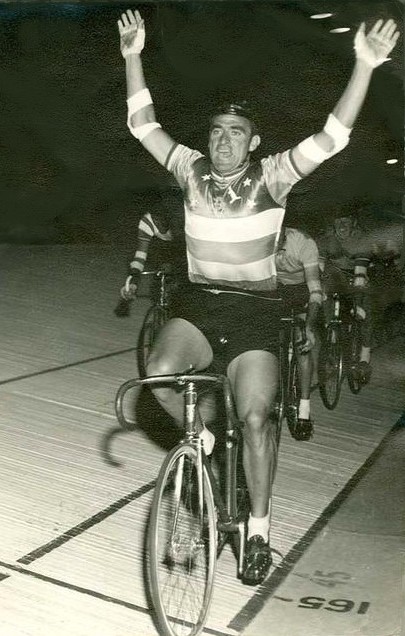
Both arms raised and deafening applause indicate this is a special win for the mighty Patto - 40 years since a scratchman had won the famous Austral.
The year before, Bill Long took over as promoter of the Olympic Velodrome and introduced betting in the next year which proved to be very popular with the capacity crowd.
With Patterson in such form despite his increasing age, but still having the special timing and judgment to conquer the particular demands of the velodrome, the question was would he ever be able to do it again. The answer was clear two years later in 1964.
He was the sole scratchman in the final but it was known that the five backmarkers had made a shared agreement. The other riders were Perry, 15, Lawrie, 25, Young and Ciavola, 40.
The gap then was 60 yards. The frontmarkers had no apparent plan so Patto became only the third rider to win two Australs. The others at the time were Harry Lambton in 1887 and 1892, and Frank Corry in 1910 and 1925.
The Olympic Velodrome was host to the Austral Wheelrace for thirteen years. During that time, Victorian and interstate champions rode off scratch or tight backmarks but Patterson was the only one to list on the exclusive Austral Honour Roll.
Velodrome promotions included quite a number of imported world or near world champions who performed in match races or the six-days but couldn't quite come to grips with the handicap. There were of course some interesting stories, personalities, and outcomes from the winners list.
1966 was one noteworthy result. With 21 years of racing experience behind him the shrewd and calculating Bill Dove rode from 150 yards, hit the front entering the straight, and held his lead to the line. Now at 37 years of age, he had been runner-up three times in past Australs and at this particular time was actually an active member of the League of Victorian Wheelmen Council.
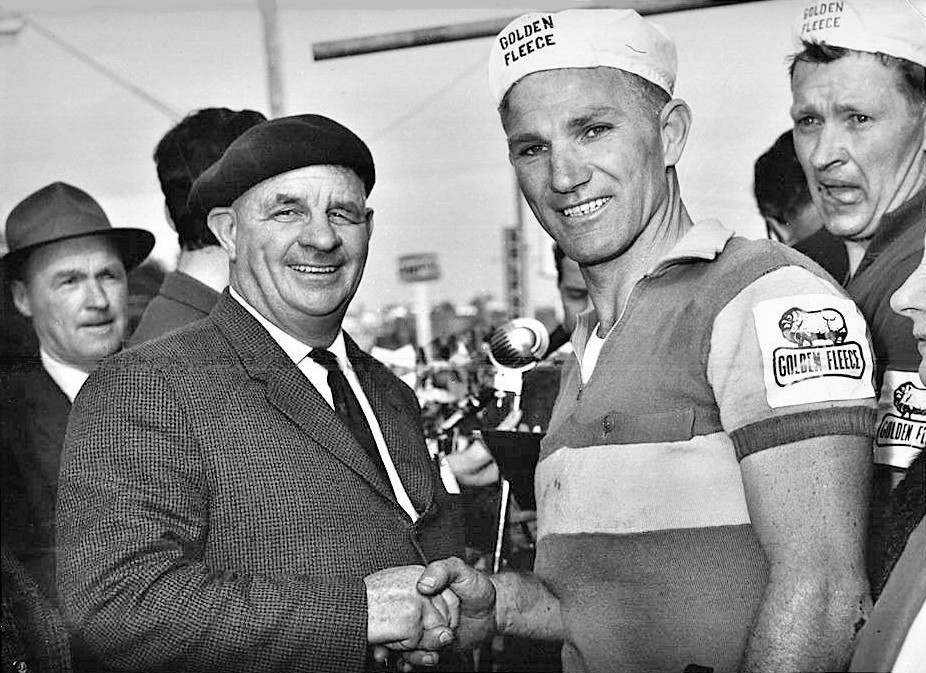
Not only an Austral winner but Bill Dove won the Melbourne to Warrnambool just months prior in back-to-back seasons. Seen here being congratulated by Sir Hubert Opperman, himself a three times fastest finisher in the Warrnambool.
But there is more to this story. Just six months before, he had won the Melbourne to Warrnambool with a riding time of seven hours and 22 minutes.
History would say the Warrny and Austral double can't be done at any time let alone back-to-back. Apparently nobody told Bill Dove that. Surprisingly he is not alone for checking old records; James Carpenter won the Melbourne to Warrnambool in 1896 and the Austral in 1897.
The 1967 Austral is another story of great achievement. Vic Browne had won Amateur Sixes at Bendigo 1960 with Bill Lawrie and the Olympic Velodrome 1961 with Doug Adams.
He then rode in the team pursuit at the 1964 Tokyo Olympics but in 1966 declared he was finished with cycling, upset by other accidents in the sport, but also likely being in need of a break from his training.
He bounced back as a professional and took the 1967 Austral from 65 yards. There was an extremely powerful scratch bunch but they were not organised whereas Browne succeeded by chasing the frontmarkers instead of joining the scratchmen.
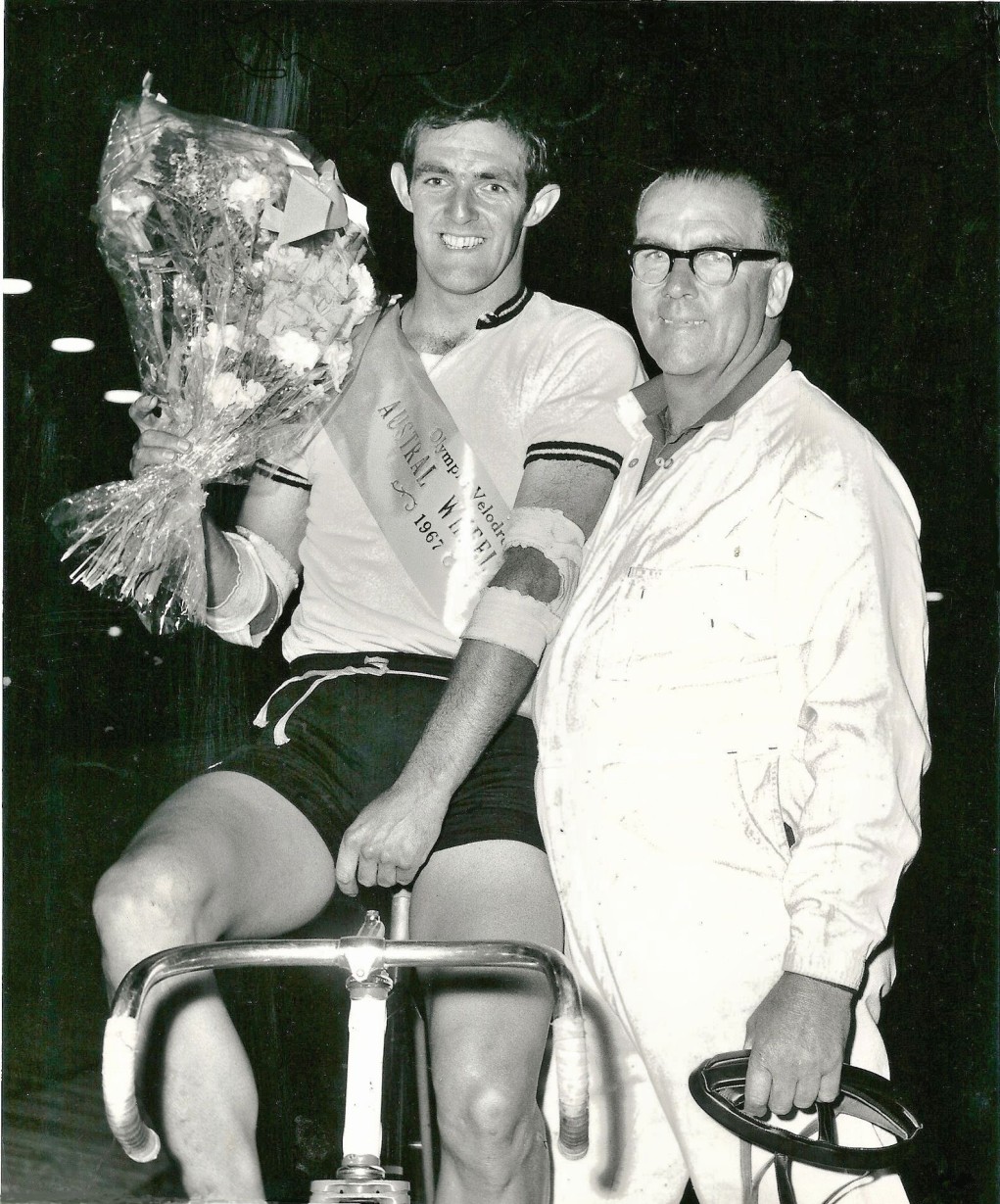
Olympian Vic Browne won the 1967 Austral from 65 yards by chasing the frontmarkers rather than waiting for the powerful backmarkers group. Pictured here with his father and great coach Harry Browne, he went on to set many long distance road records.
Browne's achievements went beyond that as he turned to long distance record breaking managed by Bill Long. In 1969, he broke Sir Hubert Opperman's Perth to Sydney record by more than two days and held eight Australian distance records.
The 1969 Austral winner was to become known for more than just that win. Charlie Walsh came over from Adelaide to win the Melbourne Cup on Wheels at the start of the season then returned later to take the Austral.
Walsh was on 50 yards and went with the middlemarkers, effectively putting the three scratchmen out of the placings. An unusual feature of the race was first prize was not money but a new Morris Mini car.
Walsh later became the national track coach and part of Australian cycling folklore as he led the Australian team to gold in the team pursuit at the Los Angeles 1984 Olympics.
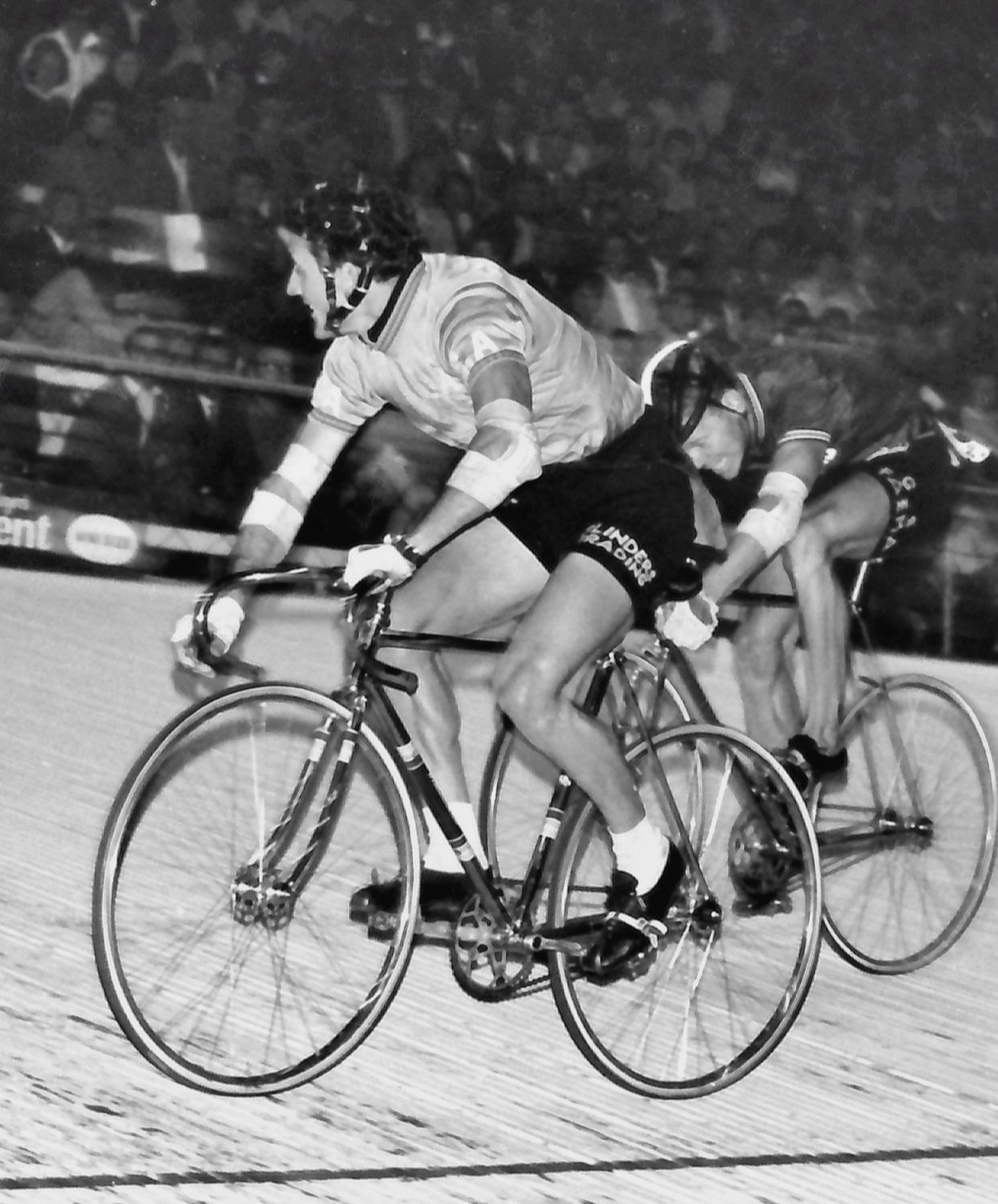
From Adelaide, Charlie Walsh won the Melbourne Cup on Wheels early in the season then the 1969 Austral. First prize was a Morris Mini car. He later became national track coach where he famously brought Australia gold in the team pursuit at the 1984 Los Angeles Olympics.
A year later and the cycling news was not good. The once great Olympic Velodrome was closing and would be removed.
The 'official rumour' was that Melbourne was going to get an indoor velodrome, but at such short notice, the immediate fact was that there would be nowhere in Melbourne to continue Saturday night cycling promotions.
If there is any fame in it then Bill Stevens was the rider to win the last Austral Wheelrace at the Olympic Velodrome.
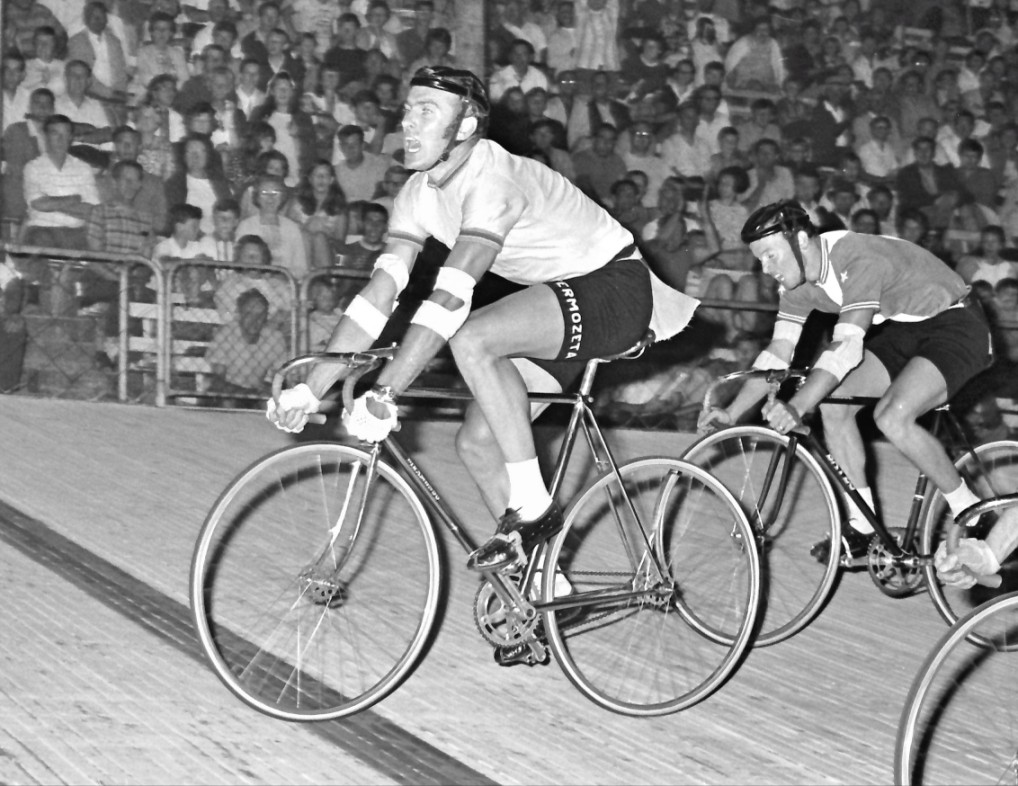
In 1970, Bill Stevens from Bendigo riding from 135 yards wins the last Austral to be held at the Olympic Velodrome. The wheel inside belongs to Gordon Maloney taking 2nd and on top is Geoff Edmonds, third.
Stevens was 29 years old and from the ever-strong Bendigo club. He rode from 135 yards and once again the scratchmen did not figure in the placings.
There was an historic touch to the prizegiving, with it performed by Iddo 'Snowy' Munro, who rode fastest time in the 1909 Warrnambool and in so doing beat the train by five minutes.
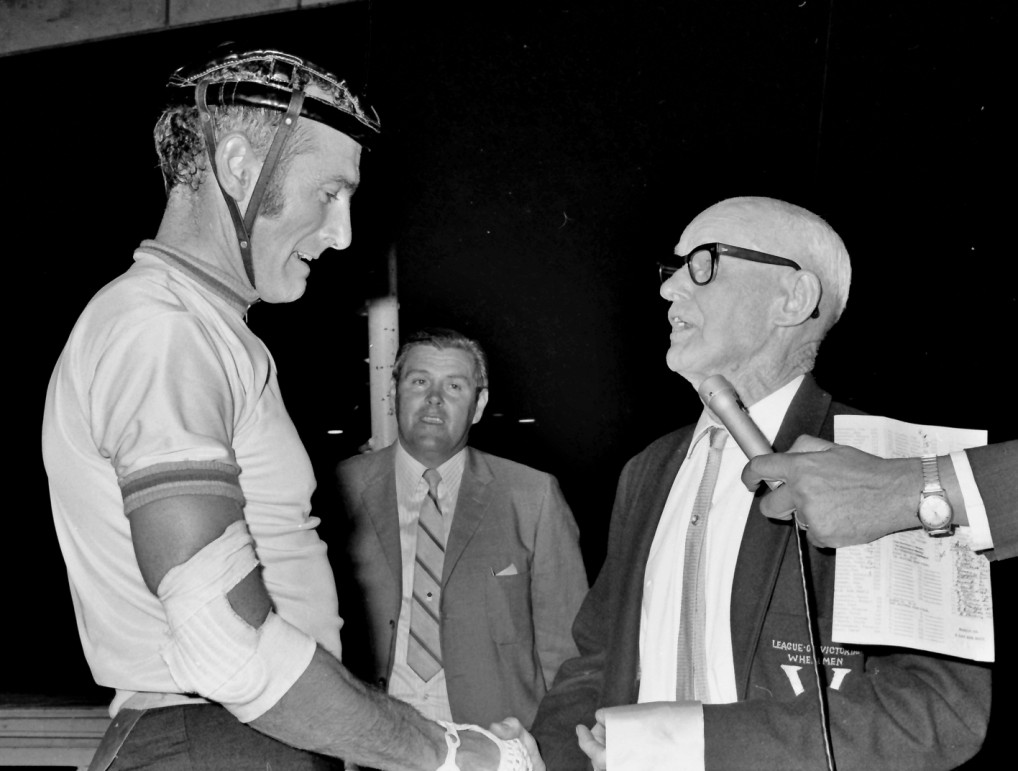
A historic touch to the presentation being made by Iddo 'Snowy' Munro who rode fastest time in the 1909 Warrnambool and beat the train by five minutes. Promoter Bill Long in the background.
At the end of the night on February 15, 1970, the lights were turned off and Melbourne, and indeed the whole state of Victoria, wondered what would we be doing next season.
How would the 72 event history of the Austral Wheelrace be continued? The only certainty was that we would not be racing on a board track.
